These are challenging times for many law firms and legal services. Uncertainty about the economy, a war in Europe, combative political environments around the world, and a battle for top talent are just some of the variables increasing marketplace unpredictability. These challenges are taking a toll on law firm growth. In fact, the following chart from our research shows that when compared to other professional services industries, law firms and legal services come in last for median growth rate at 7.2%.
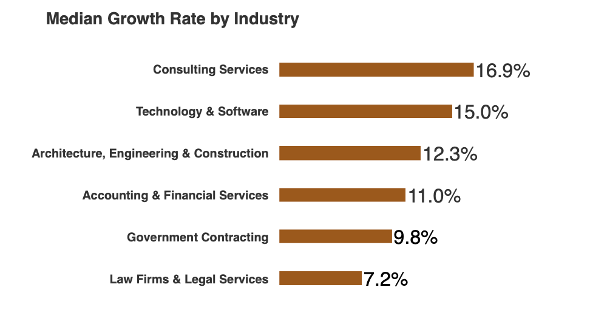
However; even with all this uncertainty and unpredictability, the High Growth Study 2023: Law Firms & Legal Services Edition from the Hinge Research Institute shows that there is still a set of law firms that are experiencing dramatically more growth—and profitability–than other law firms. We call them “High Growth” firms.
How are they doing it?
In this year’s High Growth Study: Law Firms & Legal Services Edition, we dig deeper into how this exceptional group of law firms delivers consistent, on-going success. We examine the technologies they use and how those technologies drive growth. And we dive into the role that marketing plays in a law firm and how it impacts a firm’s overall performance. We also go deep inside the war for talent—exploring the role culture plays in attracting and retaining professionals, and we identify the kinds of programs that are most likely to make a positive impact.
About the Study
Every year, the Hinge Research Institute conducts a study of professional services firms to identify emerging trends and determine what the fastest growing, most profitable firms do differently. The study is comprised of more than 700 participants from six core industries and then is broken out into industry editions of the study. Law firms & legal services is one of those industries and industry participation made up 11.3% of the overall study. The other five industries are: accounting & financial services; architecture, engineering, & construction; consulting; government contracting; and technology & software. As shown in the chart below, respondent firm size based on annual revenue was fairly equal across for size categories. Full research reports are available for sale for each of the six industries. (Use the discount code, GROW50, and save 50% on a report purchase.)

As the following figure shows, most of the law firm report respondents were from the United States but there was representation from around the world.
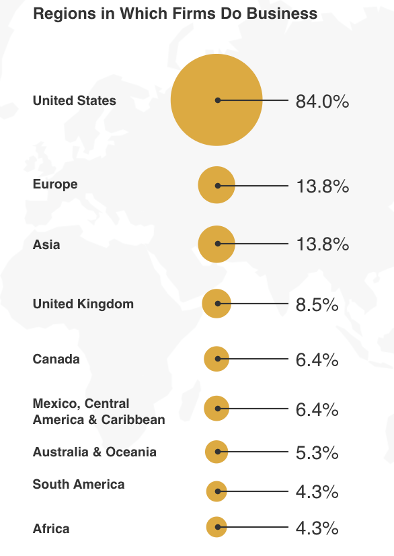
About half of the respondents (50.1%) had the title of owner, CEO, president, or partner. More than 26.0% of the respondents had marketing or business development responsibilities. The rest of the respondents had operations, financial, or attorney roles.
Meet the High Growth Firms
In our research, High Growth firms are defined as those firms that achieve at least 20% compound annual growth over a three-year evaluation period. These firms are then compared to firms that experienced average or no growth over the same time frame. This allows us to identify strategies and practices that are associated with faster and more profitable growth.
This year, the High Growth law firms in our sample experienced a median growth rate of 36.0%. This contrasts significantly with 8.0% median growth increase that Average Growth firms saw. No Growth firms averaged a 6.0% decline.
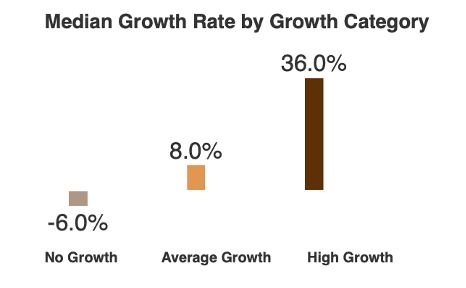
The enviable performance of the High Growth law firms is not limited to their exceptional growth rates. They are also more profitable. High Growth law firms showed an average profit of 32.0%. By contrast, No Growth law firms showed an average profit of 22.0%. High Growth law firms are 45% more profitable than No Growth firms. Imagine if your law firm were 45% more profitable.
So, how do these High Growth law firms generate greater growth and profitability in a crowded and unpredictable marketplace. Our research identified key advantages in four critical domains: Technology, Talent, Marketing and Business Development, and Strategy.
Let’s dive into a few key findings and conclusions from the High Growth 2023: Law Firms & Legal Services Edition research.
Key Advantage #1: Technology
As High Growth law firms and legal services are moving towards integrating processes across departments, it should come as no surprise that both No Growth and High Growth firms use accounting and financial management technology at similar levels of engagement. However, what is surprising is how much more High Growth firms use other business technologies than No Growth firms. In almost every business development technology category, High Growth firms have a higher level of engagement. But there are a few categories where High Growth firms are using the technology significantly more than No Growth firms. Some of those categories include: project management, CRM, time & expense tracking, and marketing automation. These technologies are giving the High Growth firms new levels of effectiveness and efficiency that lead to greater growth.
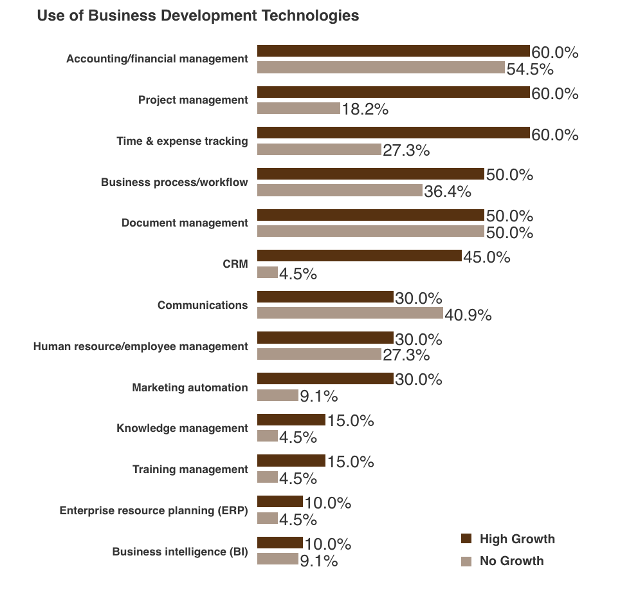
The research shows that the High Growth firms have a higher level of digital maturity with these technologies which is leading to more processes being streamlined and fully integrated across departments. Vast amounts of inter-departmental data are providing insights across the law firms and legal services.
Key Advantage #2: Talent
It was very apparent in our research that High Growth firms are more likely to engage with outside agencies, firms, or freelancers for all services compared to No Growth firms. The High Growth firms can handle more projects and can keep projects moving ahead by leveraging outside resources that may not take as much time to hire or bring up-to-speed. They realize that they do not need certain specific expertise in house on a full-time basis. They may only need that expertise for several months or a few hours per week. Some of the areas where High Growth firms are using outside skills and expertise to grow include: website improvements, marketing materials development, research, SEO, and strategic development.

Key Advantage #3: Marketing and Business Development
According to the 2023 research, High Growth law firms also differentiate themselves from No Growth firms when it comes to growth by spending more on marketing and getting more leads from digital sources. High Growth law firms and legal services spend 33% more on marketing than No Growth firms. This means more of an investment in resources, including more access to technology, talent, and marketing channels. This larger investment also delivers more digital leads. In fact, as you can see in the following figure, High Growth firms generate twice as many leads from digital sources than their No Growth peers.
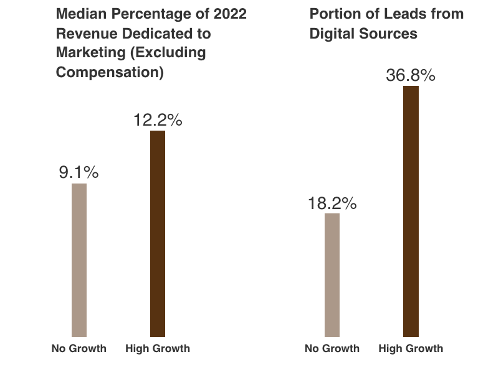
Digital leads are more important than ever. According to other research from the Hinge Research Institute, referrals are declining in many industries. Even as face-to-face lead generation activities such as conferences and networking events are experiencing a revival, High Growth firms are also enjoying a steady stream of digital leads to supplement unpredictable lead generation from other channels. High Growth law firms and legal services have realized that they can no longer rely on just a couple of channels to generate all of the new business they need in these times.
Key Advantage #4: Strategy
When it comes to anticipated business challenges in the next three to five years, there are several challenges where High Growth firms and No Growth firms do not see eye-to-eye. A shortage of top talent and the need for new skills are the two top challenges for High Growth firms. Yet, while 50.0% of High Growth firms see a shortage of top talent to be their top challenge for the next few years, only 13.6% of No Growth firms feel that way. The need for new skills was the #2 challenge garnering 40.0% of High Growth firm responses. This #2 challenge was only selected by 22.7% of No Growth firms.
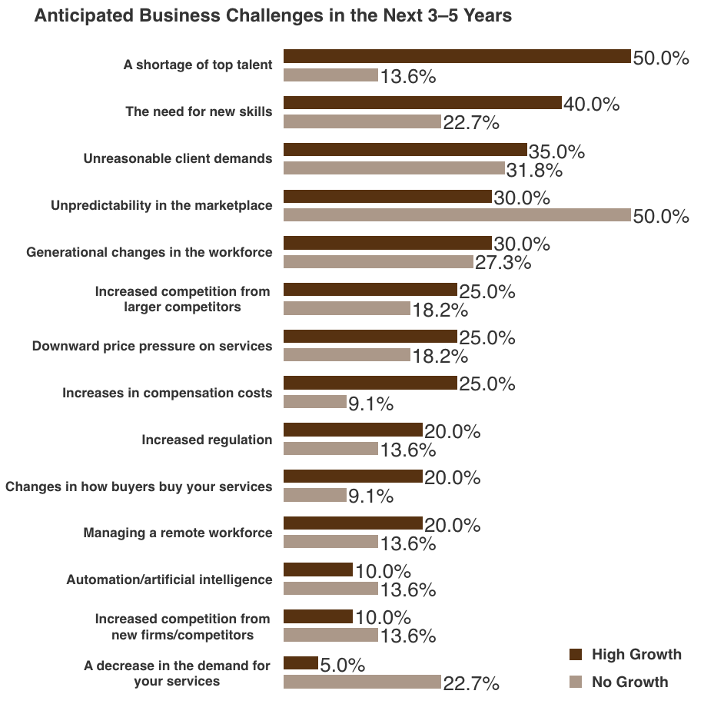
This makes sense. High Growth firms are facing a situation that No Growth firms are not—high growth. The rapid growth that High Growth firms are seeing demands top talent and new skills to keep with delivering an ever-expanding volume of quality work. The No Growth firms’ #1 challenge is unpredictability in the marketplace. The #2 challenge for No Growth firms is unreasonable client demands. No Growth firms have more focus and sensitivity on not growing. There may be position vacancies that are not backfilled. There may even be an organization right-sizing. Then on top of that, No Growth firms still must deliver as much—if not more—to keep existing clients satisfied and not lose business.
With these different perspectives comes different strategies. High Growth firms are building pro-active strategies that may include offering higher salaries, larger bonuses, more paid time off, etc. They are focused on handling increases in compensation costs. No Growth firms are building reactive strategies that may include projected full-time employee, part-time employee, and contractor reductions. They are focused on making decreases to budgets, expenses, and compensation.
Even though High Growth firms and No Growth firms are embracing the future differently, both are using research as part of their future strategic plans. Both groups realize that research reduces uncertainty and uncovers valuable information about target clients and competitive environments. Conducting research on a regular basis allows law firms and legal services to identify shifts in buyer behavior and determine which changes are likely to persist and which are likely to be short-term blips.
We Live in an Age of Uncertainty…and Change.
If you are working for a High Growth law firm or legal service in these unpredictable times, congratulations. Hopefully you have validated growth tactics that your firm has already put into place. Or maybe you learned a new one that you can add to your strategy for even greater success in the months ahead.
If you are part of a law firm or legal service that saw average or no growth over the last year or two, now is the time to turn those challenges into opportunities. Embrace new thinking and priorities. Follow the research. In fact, I would recommend that you purchase the High Growth Study 2023: Law Firms & Legal Services Edition report that this article is based upon. Learn more about the technology, talent, marketing and business development, and strategy advantages that the High Growth firms have. Get findings, insights, and tips that you can apply immediately. The High Growth firms in this research found ways to work around uncertainty—and grow. You can too. Purchase the Law Firms & Legal Services Edition, or any of the other five industry editions, today. (Remember to use the discount code, GROW50, to save 50% on your research report purchase.)

